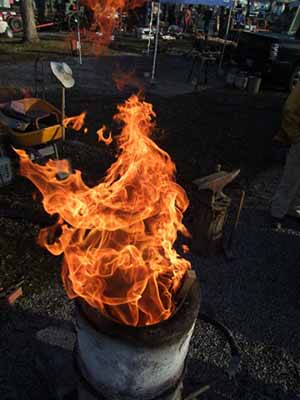| |
11:14 a.m. March 30, 2014
Pigeon Forge ore smelted for first time in 150 years

At the beginning of the ore smelting process, this blaze is from burning charcoal which eventually created a slow burn and increased the heat to smelt ore. Image courtesy of Christopher Price, The Tidewater Forge - Alexandria, Virginia. |
|
| |
|
PIGEON FORGE, TN — The Pigeon Forge Iron Works that gave Pigeon Forge its name discontinued operations about the time of the Civil War. Through efforts to preserve the town’s history, a group of experimental metal workers came to Pigeon Forge to demonstrate the age-old smelting process using local iron ore from the original ore banks.
A smelting furnace was brought in and pieced together at Clabough’s Campground as a part of the annual Saddle Up event February 22. Iron ore that had been heated and crushed was sandwiched between charcoals and continually reloaded into the furnace as the ore heated, transforming to malleable iron. In the process, the furnace was tapped and hot waste or slag rolled out of the base the way it would have in Pigeon Forge’s early bloomary furnace by the Old Mill.
About fifty-five pounds of ore and a hundred and sixty pounds of charcoal produced a BIG solid bloom estimated at between sixteen and twenty pounds. This bloom or chunk of iron will be placed in a forge and reheated so that it can be hammered into bars. The bars can be crafted into useful items such as knife blades.
An 1820 manufacturing census record tells that Isaac Love used one hundred tons of pig metal annually, employed five men, and produced bar iron valued at $9,600 in Pigeon Forge. The Iron Manufacturer’s Guide to the Furnaces, Forges and Rolling Mills of the United States by J.P. Lesley in 1859 stated that the Pigeon Bloomary Forge, owned and managed by John Trotter, had one bloomary fire and one hammer driven by water. It made, in 1856, perhaps two tons of bars. The site where the furnace operated was discovered in the fall of 2013 underneath the Old Mill General Store when the researchers from the University of Tennessee’s Archaeological Research Lab excavated a small area in search of the historic site.
Alan Longmire, a Tennessee Department of Transportation Archaeologist from Johnson City was joined by Dr. Jesus Hernandez, Dennis McAdams, Mark Green, and Christopher Price, all bladesmiths, researchers in iron making, or smelters who are among the few in the world skilled in this process that dates back to medieval times.
“Pigeon Forge was fortunate to step back in time and view the making of iron using methods that gave long ago farmers vital tools for survival,” said Veta King, Pigeon Forge Public Library’s historian.
Published March 6, 2014
|
|
|

